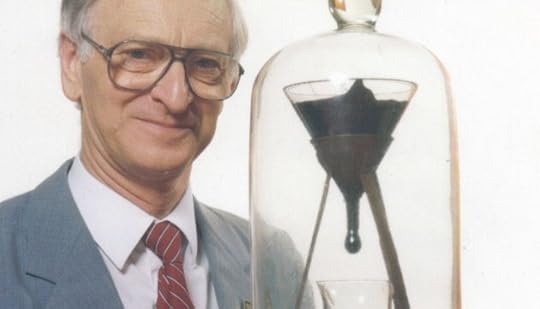Bathroom Readers' Institute's Blog, page 58
June 21, 2017
Still Going!

For centuries, inventors have been pursuing the concept of a perpetual motion machine—a device that generates its own power and, like the Energizer Bunny on TV commercials, keeps “going, and going, and going…” Here are two real-life objects that are doing just that. (This story is a sneak peek from our 30th annual edition, Uncle John’s Old Faithful Bathroom Reader, available November 2017.)
 The Beverly Clock
The Beverly ClockWhat It Is: A mechanical “weight-driven” clock—similar to a grandfather clock—that has never needed winding since it was first wound in 1864.
Details: Arthur Beverly (1822–1907) was a Scottish-born clockmaker, mathematician, and astronomer who emigrated to New Zealand in 1857. He built his famous clock for the New Zealand Exhibition of 1865.
Ordinary weight-driven clocks are powered by a weight hanging from a chain. The chain is wrapped around a cylinder called a drum, and as gravity pulls on the weight, the chain causes the drum to turn.
The drum is connected to an assembly of gears that connect to the hour and minute hands of the clock: When the drum turns, the gearwheels move, and that causes the hour and minute hands to move, which is how the clock tells time.
Over a given period of time, the action of the clock causes the chain to unwind from the drum. And as it unwinds, the weight sinks lower and lower inside the clock. Eventually an ordinary weight-driven clock will have to be manually wound, usually by inserting a key into the face of the clock and turning the key. Doing so rotates the drum in the reverse direction, winding the chain back around the drum and lifting the weight higher inside the clock.
Changing Time: Beverly’s clock is different. It has never needed winding because it winds itself. The clock contains a sealed, airtight box containing about a cubic foot of air. A diaphragm is attached to the box, and as the air inside the box expands or contracts due to changes in air temperature or atmospheric pressure, the diaphragm moves. It moves outward when the air in the box expands, and inward when it contracts.
The movement of the diaphragm is the mechanism that winds the clock. A difference of as little as 6°F during the day will move the diaphragm enough to lift the weight one inch inside the clock, which is enough to keep the clock ticking the entire day. Result: The clock has run almost continuously since Beverly first wound it up in 1864, more than 150 years ago. The only times the clock has stopped ticking are 1) when its owner, the Physics Department of the University of Otago, in Dunedin, New Zealand, stops it deliberately in order to clean, move, or repair it; or 2) on those rare days when the difference in temperature between the hottest and coldest part of the day is less than 6°F. On such occasions the clock does stop, but only temporarily: as soon as the temperature begins to change the clock starts working again, without needing to be wound. Arthur Beverly is the only person who ever wound the clock, and he only wound it once.
If you ever have an opportunity to visit Dunedin, on the South Island of New Zealand, be sure to drop by the University of Otago and have a look at the Beverly Clock. It’s on display on the third floor of the Physics Department building near the elevator. And if you can’t get to New Zealand for 10, 20, or perhaps even 50 years or more, don’t worry. It’s a pretty safe bet the Beverly Clock will still be ticking away when you get there.
The Oxford Electric Bell
What It Is: A battery-powered bell that has been ringing continuously on the same set of batteries since 1840. The device is on public display near the main entrance of Oxford’s Clarendon Library.
Details: An Oxford University physics professor named Robert Walker bought the device in 1840 from Watkins and Hill, a London firm that made scientific instruments. The device consists of two brass bells less than an inch apart. The bells are mounted on vertical brass rods, and above each bell is a battery, which looks like a candlestick. A tiny metal sphere suspended on a silk thread between the batteries serves as the clapper that rings the bells.
When the sphere touches the first bell, it completes an electrical circuit that gives that bell an electrostatic charge. This charge repels the sphere, pushing it away from the first bell toward the second bell.
When the sphere touches the second bell, that bell becomes charged and repels the sphere back toward the first bell.
Huh?! This sequence of events has been repeating itself since the bell was set up in 1840. It’s estimated that the bells have rung some 10 billion times since then. Ironically, because the device is protected by its own glass cover and sits inside a glass display case, the bells can be seen ringing, but they cannot be heard.
No one knows how much longer the bells will ring. That depends on what the batteries are made of, and no one knows for sure. The curious are left to wait for the batteries to die before they can be taken apart to see what’s in them. They’ve waited more than 170 years already and may have centuries more to go.
#mc_embed_signup{background:#fff; clear:left; font:14px Helvetica,Arial,sans-serif; }
/* Add your own MailChimp form style overrides in your site stylesheet or in this style block.
We recommend moving this block and the preceding CSS link to the HEAD of your HTML file. */
Subscribe to our mailing list and download a sampler of our 30th annual edition, Uncle John’s Old Faithful Bathroom Reader. Check your email for download link.
* indicates required
Email Address *
Country
United States of AmericaCanadaOther

The post Still Going! appeared first on Trivia Books and Facts | Uncle John's Bathroom Reader.
June 20, 2017
Survival Stories

Never underestimate the power of the human spirit. (This story is a sneak peek from our 30th annual edition, Uncle John’s Old Faithful Bathroom Reader, available November 2017.)

The Mad Adder
Teenage brothers Brock and Josh Leach (14 and 16, respectively) were exploring the top of a seaside cliff in Cornwall, England, in July 2015 when Brock slipped and fell 100 feet down. He hit several rocky outcroppings before landing hard on a ledge just above the churning sea. Hurt but alert, Brock knew he had to get to higher ground before the tide came in, but he’d fractured his pelvis and couldn’t walk. So he reached up and grabbed a rock, hoping to pull himself up…and suddenly felt a stabbing pain in his right hand. Then he saw it: an adder—the only venomous species of snake in the UK—slithering away from him. Brock’s hand started swelling to three times its normal size. A few minutes later, Josh arrived after scrambling down the cliff. He helped his brother get to a higher ledge, but Brock was in too much pain to move any farther. So Josh, who didn’t have a mobile phone, climbed all the way back up to the top and started yelling for someone to call 9-9-9 (Britain’s 9-1-1). It worked. Not long after, rescuers from the coast guard arrived and helicoptered Brock to the nearest hospital, where he was given antivenin. He made a full recovery.
Buried Alive
Around midday on April 25, 2015, Rishi Khanal was on the second floor of a seven-story hotel in Kathmandu, Nepal, when the building started shaking violently. The next thing the 27-year-old man knew, he was trapped in complete darkness beneath several tons of rubble. He tried moving, but something was crushing his leg. So he tried yelling, but no one could hear him. Minutes passed, then hours. Then days. He could smell dead people all around him. “I was certain I was going to die,” Khanal later told ABC News. But even so, he didn’t give up. He “fed” himself with the only sustenance he could get: his own urine. After 82 long hours, a French rescue team finally heard him banging on rocks and started digging as fast as they could. The 7.8-magnitude earthquake killed more than 8,000 people, but Khanal beat the odds and made it out alive.
Down in the Dumps
Yang Hsieh, a 28-year-old construction worker in China’s Hunan province, was the last one at the job site when he accidentally took a step in the wrong direction and fell over a ledge. When he came to an abrupt stop 65 feet below, both of his arms and legs were broken, as was his phone. He’d landed in a dark pit deep in the bowels of the building project, so no one could see him or hear his cries for help. When Yang didn’t show up for work the next day, his fellow workers assumed he’d found a new job and changed his phone number. But Yang was right underneath them the whole time…for six days. On the seventh day, a woman walking her dog heard his faint cries and discovered Yang barely clinging to life. He was taken to a hospital, where he was expected to make a full recovery. When asked how he managed to not die of thirst, Yang confessed, “I had to drink my own urine for six days to stop myself dehydrating.”
#mc_embed_signup{background:#fff; clear:left; font:14px Helvetica,Arial,sans-serif; }
/* Add your own MailChimp form style overrides in your site stylesheet or in this style block.
We recommend moving this block and the preceding CSS link to the HEAD of your HTML file. */
Subscribe to our mailing list and download a sampler of our 30th annual edition, Uncle John’s Old Faithful Bathroom Reader. Check your email for download link.
* indicates required
Email Address *
Country
United States of AmericaCanadaOther

The post Survival Stories appeared first on Trivia Books and Facts | Uncle John's Bathroom Reader.
June 16, 2017
The Class of 2016

A huge number of famous people died in 2016. Not only were they widely respected, but as this post confirms, they were highly quotable. (This story is a sneak peek from our 30th annual edition, Uncle John’s Old Faithful Bathroom Reader, available November 2017.)

“It isn’t the mountains ahead to climb that wear you out; it’s the pebble in your shoe.”
— Muhammad Ali (1942-2016)
“I think there should be laughs in everything. Sometimes it’s a slammed door, a pie in the face, or just a recognition of our frailties.”
— Alan Rickman (1946-2016), actor
“Youth and beauty are not accomplishments.”
— Carrie Fisher (1956-2016), actress and author
“A long time ago, I realized that I loved to sing, dance, and make people laugh. The trick is finding something that you like and sticking with it.”
— Debbie Reynolds (1932-2016) actor
“It’s always helpful to learn from your mistakes because then your mistakes seem worthwhile.”
— Garry Marshall (1934-2016), writer/director
“It’s not the hair on your head that matters; it’s the kind of hair you have inside.”
— Garry Shandling (1949-2016), actor and comedian
“You never really understand a person until you consider things from his point of view.”
— Harper Lee (1926-2016), author of To Kill a Mockingbird
“You learn something out of everything, and you come to realize more than ever that we’re all here for a certain space of time, and then it’s going to be over, and you better make this count.”
— Nancy Reagan (1921-2016), former First Lady
“I’ll tell you what the public likes more than anything, it’s the most rare commodity in the world: honesty.”
— Merle Haggard (1937-2016), singer/songwriter
“There is a crack in everything, that’s how the light gets in.”
— Leonard Cohen (1934-2016), singer/songwriter
“Just remember, strength and courage. If you stand on principle, you’ll never lose.”
— Janet Reno (1938-2016), former U.S. Attorney General
“Concentration comes out of a combination of confidence and hunger.”
— Arnold Palmer (1929-2016), golfer
“Macho does not prove mucho.”
— Zsa Zsa Gabor (1917-2016), actress
“We are humans. There is a finite end to this life and we’re all going to face it, and a little silliness can help.”
— Alan Thicke (1947-2016), actor
“Except for a few guitar chords, everything I’ve learned in my life that is of any value I’ve learned from women.”
— Glenn Frey (1948-2016), singer/songwriter
“Life is just a party, and parties weren’t meant to last.”
— Prince (1958-2016)
#mc_embed_signup{background:#fff; clear:left; font:14px Helvetica,Arial,sans-serif; }
/* Add your own MailChimp form style overrides in your site stylesheet or in this style block.
We recommend moving this block and the preceding CSS link to the HEAD of your HTML file. */
Subscribe to our mailing list and download a sampler of our 30th annual edition, Uncle John’s Old Faithful Bathroom Reader. Check your email for download link.
* indicates required
Email Address *
Country
United States of AmericaCanadaOther

The post The Class of 2016 appeared first on Trivia Books and Facts | Uncle John's Bathroom Reader.
June 15, 2017
The Magical Fruit

This page won’t amount to a hill of beans—or maybe it will, because it’s a page about beans. (This story is a sneak peek from our 30th annual edition, Uncle John’s Old Faithful Bathroom Reader, available November 2017.)
Beans are the edible seeds of larger plants, and they grow in visible, pickable pods, so technically, beans really are a fruit. (“Magical” is still a matter of opinion.)
One bean not considered a bean: the green bean. Federal nutritional health guidelines consider it a vegetable, not a starchy legume like other beans.
Reason: it contains far less fiber and protein than its beany brethren.

Green beans are also one of a handful of bean varieties that cannot and should not be eaten raw…because they’re toxic. They’re high in lectins—a protein that can cause gastric distress, but can be easily neutralized by cooking.
Canned baked beans, particularly Heinz’s baked beans, are extremely popular in Great Britain, where they’re considered part of the “traditional English breakfast.” As a nation, Britons consume on average 38.5 tons of baked beans every hour. (That’s four times the American consumption rate.)
Wedding custom in Nicaragua: the newlyweds are given a bowl of beans, which is thought to bring good luck and longevity to their marriage.
January 6 is National Bean Day. Reason: It’s the day famed geneticist Gregor Mendel died in 1884. Many of Mendel’s theories on genetics derive from experiments he did with bean plants.
The United States’ most prolific bean producer: North Dakota, with 475,000 acres dedicated to growing beans. That’s 1 percent of North Dakota’s entire area.
Top five most-grown bean varieties in the United States: pinto beans, navy beans, black beans, kidney beans, and great northern beans.
The influential sixth-century Greek philosopher Pythagoras taught his followers that the souls of dead humans traveled to the underworld (Hades) through the hollow stems of bean plants, and that those souls lived in the beans. Result: He thought it was sinful to eat beans or even walk through bean fields.
Beans were cultivated in ancient Rome and were so respected as an ideal food source that several prominent families were all named for the humble legume. They were: Fabius (for the fava bean), Piso (for the pea), Lentullus (lentils), and Cicero (chickpeas).
Beans, or rather legumes, are one of the few cultivated plants that actively enrich the soil in which they grow. Legume roots are equipped with nodules that, as the beans grow, add nitrogen to the dirt.
Beans are the most concentrated non-animal source of protein in the world. As much as 11 percent of a cooked bean is protein. They’re also the cheapest protein source. Ground beef and chicken cost, on average, around $1 per four-ounce serving. Cost of a half-cup serving of pinto beans: around 10 cents.
In 2012, a Macedonian man named Davcev Stojan cooked up the world’s largest-ever pot of baked beans—a record 1,476.36 gallons.
Another world record: In 1986, Barry “Captain Beany” Kirk sat in a bathtub full of cold baked beans for 100 hours.
About 72,000 people worldwide have the last name of Bean.
Don’t worry, we’ll answer the main question about beans. The reason they lead to excessive flatulence is because they contain a carbohydrate chain called oligosaccharides. Humans lack the digestive enzyme to process them properly, so intestinal bacteria ferment them instead. The side effect: gas.
#mc_embed_signup{background:#fff; clear:left; font:14px Helvetica,Arial,sans-serif; }
/* Add your own MailChimp form style overrides in your site stylesheet or in this style block.
We recommend moving this block and the preceding CSS link to the HEAD of your HTML file. */
Subscribe to our mailing list and download a sampler of our 30th annual edition, Uncle John’s Old Faithful Bathroom Reader. Check your email for download link.
* indicates required
Email Address *
Country
United States of AmericaCanadaOther

The post The Magical Fruit appeared first on Trivia Books and Facts | Uncle John's Bathroom Reader.
Who’s More Famous: The Kid or the Dad?

We all learn how to do things from our parents, and for famous people, that includes being famous. Here are some celebrities who had famous parents that you might not have known were also in the public eye.

Robert Pine
Chris Pine is currently co-starring in the smash hit Wonder Woman, and he’s best known as Captain Kirk in the latest round of Star Trek movies. He did not star in the flop movie adaptation of the ‘70s series CHiPs…but his father, Robert Pine, co-starred on the show. For six seasons, the veteran actor played Sgt. Joseph Getraer, and then had a recurring role on Magnum, P.I. as Thomas Magnum’s father.
Lee Ferrell, Jr.
Ferrell, Jr.’s junior is comic superstar Will Ferrell. Ferrell has often sung on movies and on Saturday Night Live, but he probably got his chops from his dad, who played saxophone and keyboards for the Righteous Brothers—he was part of the venerable duo’s touring band off and on for more than 20 years.
Sir William McMahon
Julian McMahon has been a presence on television for more than 15 years, co-starring on hits like Charmed and Nip/Tuck. He almost always plays American characters, hiding his natural Australian accent. He’s quite Australian: His father was Sir William McMahon, who served as prime minister of Australia from 1971 to 1972.
Ed Begley, Sr.
Ed Begley, Jr. is probably the more famous Ed Begley, Jr. at this point. But the noted environmentalist and St. Elsewhere star had to add that suffix on to his name when his career was starting out more than three decades ago because his father was one of the most acclaimed and celebrated actors of the mid-20th century. Ed Begley, Sr. worked in every medium, including radio, TV, film, and the stage. He won a Tony Award for Inherit the Wind and an Oscar for Sweet Bird of Youth.
The dads of Girls
The entire main cast of HBO’s now-finished Girls have famous fathers.
Zosia Mamet is the daughter of noted playwright and screenwriter David Mamet (Glengarry Glen Ross). Allison Williams’s dad is former NBC Nightly News anchor Brian Williams. Jemima Kirke’s father is Bad Company drummer Simon Kirke. Creator and star Lena Dunham is the daughter of major contemporary painter Carroll Dunham.
Ravi Shankar
Elements of traditional Eastern music became more commonplace in pop and rock music in the ‘70s in part thanks to the popularity of master sitar player Ravi Shankar, and particularly because of songs he recorded for ex-Beatle George Harrison’s The Concert for Bangladesh. Shankar is the father of Norah Jones, the soft rock singer and piano player who won all four major categories at the 2003 Grammy Awards (Album of the Year, Song of the Year, Record of the Year, and Best New Artist).
The post Who’s More Famous: The Kid or the Dad? appeared first on Trivia Books and Facts | Uncle John's Bathroom Reader.
June 14, 2017
The Bottomless Beer Glass of the Czech Republic

Father’s Day is coming, and if there’s one things dads love, it’s beer. Here’s how dads (and non-dads) take their suds in different countries around the world.

Czech Republic
It’s one of the world’s biggest beer-consuming countries, and they let the beer flow freely. So freely, in fact, that you’ve got to actively make sure bartenders don’t give you too much. If you’re looking to keep track of how much you’ve been drinking, don’t set your glass down on the bar. It’s customary for bartenders in the Czech Republic to continually top it off.
Peru
Friends drink beer together in Peru…in a very specific way so as to celebrate their friendship. A shot glass is filled from a bottle of beer, and then around the table it goes, with each person pouring a shot, drinking it, and passing it down. Once the beer bottle is empty, another person takes a turn buying the beer, and the whole process with the shots is repeated until everybody in the group has bought (and shared) a bottle.
Iceland
The national spirit is a licorice-flavored spirit called aquavit. It’s very strong, and beer is used as a chaser. Here’s the way to drink in Iceland. Drinking songs are sung before, during, and after a shot of aquavit, and then a swig of beer is swigged.
Hungary
Don’t toast your beer glass in Hungary. In 1848, 13 revolutionaries were executed for leading an uprising against Austria. Austrian officials celebrated their deaths by toasting…and it’s since been considered very bad form to do this in Hungary.
Italy
Beer is never taken with dinner. (That’s the territory of wine.) Instead, beer is drank primarily in tiny, quick-service bars colloquially referred to as “Holes in the Wall.” You go in, you order your drink, you consume it fast, and then you leave. It’s like fast food, but with beer!
 For more stories and trivia about beer, check out
Uncle John’s Beer-Topia
. It’s a very refreshing gift that will make dad extra “hoppy.”
For more stories and trivia about beer, check out
Uncle John’s Beer-Topia
. It’s a very refreshing gift that will make dad extra “hoppy.”
The post The Bottomless Beer Glass of the Czech Republic appeared first on Trivia Books and Facts | Uncle John's Bathroom Reader.
It’s Flag Day

Today is a holiday commemorating the history of the American national flag, and all that it stands for. Additionally, each of the 50 states has its own flag—here are some stories about those.

The Alaska state flag predates Alaskan statehood. It depicts the North Star and the Big Dipper in gold against a dark blue background. The winning design was created for a 1927 Alaskan American Legion contest by Benny Benson, a 13-year-old boy from Seward, Alaska.
Connecticut is among the oldest states, and oldest American colonies. The design of the Connecticut flag is based on the Saybrook Colony seal, which settled in what’s now Connecticut in 1639. The flag’s three grapevines represent Windsor, Wethersfield, and Hartford, the state’s oldest settlements.
What European power held Iowa before it became an American state? The vertical blue, white, and red stripes of the Iowa state flag are a big clue—it’s modeled after the French flag. Iowa was part of the Louisiana Purchase that President Thomas Jefferson acquired from France. (Atop the stripes are an eagle holding a ribbon, which reads, “Our liberties we prize and our rights we will maintain.”)
The Alabama state flag consists of a red “X” across a white background. It is reminiscent of the design of the flag of the Confederacy, but that’s merely coincidental. It does have a Civil War origin, however. Introduced in 1895, it’s based on the flag used by the 60th Alabama Infantry Regiment.
Hawaii’s flag is the only American state flag to feature the United Kingdom’s famous red-white-and-blue “Union Jack.” That’s a reference to the time before Hawaii was a state (but after when it was an independent kingdom) to when it was a protectorate of the British empire.
The first flag of Nevada, adopted in 1905 was co-designed by its governor, John Sparks. Atop the same blue of the national flag were a bunch of gold and yellow stars, and in huge letters, the words “SILVER NEVADA GOLD.” In the 1920s, the state did away with that flag and adopted one that is all blue, and the state’s emblem shrunk down and placed in the corner.
The post It’s Flag Day appeared first on Trivia Books and Facts | Uncle John's Bathroom Reader.
June 13, 2017
Bad Hair Days

Think you’ve ever had a bad hair day? Just be glad you never had one like these folks. (This article was first published in Uncle John’s Legendary Lost Bathroom Reader.)

BACKGROUND
“One kind of day that everyone dreads is the widely known and feared bad hair day,” wrote columnist William Safire when a reader asked him about the term. Safire speculated that it started with comedian Gary Shandling. “Irritated with his coverage in Us magazine. Shandling (who used to begin his routine with ‘Is my hair all right?’) told the Seattle Times in January 1991: ‘I was at a celebrity screening of Misery and they made up a quote for me. They said I told them I was having a bad hair day. They didn’t even talk to me.” A month later the phrase appeared in the L.A. Times, then the Toronto Star (“Was Robert DeNiro caught in a crosswind, or was he just having a bad hair day?”), and now it’s a part of our lexicon.
SIX REAL BAD HAIR DAYS
Michael Jackson
In February 1984, Jackson and his brothers were filming a $1.5 million commercial for Pepsi-Cola in which he walked down a staircase as a pyrotechnic display went off behind him. They shot the scene four times, but according to Time magazine, “The effect was not quite right for Director Bob Giraldi…He asked the singer to move more slowly and ordered the fireworks ‘heated up’ a bit. The combination proved volatile: On the fiery fifth take…sparks from a smoke bomb ignited Jackson’s hair, sending the singer to the hospital with second- and third-degree burns on his scalp.
Albert Anastasia
Anastasia was head of the Mangano crime family, one of the infamous “five families” of the New York mafia. On the morning of October 25, 1957, he went for a haircut at the Park Sheraton Hotel. While his bodyguard parked the car, Anastasia sat down in the barber chair and fell asleep. Minutes later, two men wearing scarves over their faces walked up to him, drew their guns, and opened fire. Anastasia jumped out of the chair and tried to attack the gunmen, but he was too badly wounded and collapsed dead on the floor.
Hans Steininger
Steininger was a 16th-century Austrian man famous for having the longest beard in the world. In September 1567, he tripped on his beard as he was climbing the stairs to the council chamber of Brunn, Austria. He fell down the stairs and died.
Hans Hoffman
In 1993, Hoffman, a 31-year-old vagrant, robbed a Rotterdam (Netherlands) bank of $15,000, telling the teller he needed the money to get a haircut and buy a piece of cheese. A few hours later he showed up at the Rotterdam police department, surrendered, and handed over a bag full of cash. Police counted the money and it was all there minus the price of a haircut and a piece of cheese.
King Louis VII of France
King Louis had a beard when he married Eleanor of Aquitaine in 1137, but when he shaved it off, Eleanor thought he looked ugly without it and insisted he grow it back. Louis refused—so she left him and married King Henry II of England. However, Louis refused to give back Aquitaine, Eleanor’s ancestral lands, which had become part of France when the couple got married. King Henry declared war. “The War of the Whiskers” lasted 301 years, until peace was finally signed in 1453.
President Bill Clinton
In May 1993, President Clinton received a $200 haircut on Air Force One. The only problem: At the time, Air Force One was parked on the tarmac, and according to a Federal Aviation Administration official, the trim shut down two of LAX’s four runways for 56 minutes. The scene generated so much bad publicity that the hair stylist, Christophe, held a press conference to deny that Clinton was as smug, self-important, or stylish as the incident suggested.
“I am not saying this in a negative way,” he told reporters, “but from what you can see, do you really think that Hillary or Bill Clinton, are very concerned about their appearance?”
The whole thing may have been the work of a political trickster. Subsequent checks of the records at LAX showed that the haircut had actually caused no problems. Runways were not shut down, and no planes were kept waiting.
The post Bad Hair Days appeared first on Trivia Books and Facts | Uncle John's Bathroom Reader.
Going Poster
What’s the difference between a photo and a poster? A poster is a photo that’s been cropped, edited, blown up, edited, mass-produced on cheap paper…and purchased by millions. Here’s a look behind some of the most famous and best-selling posters of all time. (This story is a sneak peek from our 30th annual edition, Uncle John’s Old Faithful Bathroom Reader, available November 2017.)

PINK FLOYD’S BACK CATALOG
In 1996 graphic designer Storm Thorgerson and his design firm, Hipgnosis, were hired to make a TV commercial to advertise the re-release of the back catalog of British rock band Pink Floyd, including Atom Heart Mother, Dark Side of the Moon, Wish You Were Here, Animals, and The Wall. When Thorgerson suggested to the band’s label, EMI, that he wanted to take the suggestion literally—and film a bunch of young women with their bare backs painted with the cover art of a different Pink Floyd album—the executives loved it. But they thought it would be better as a promotional poster for record stores than as TV commercial. A body painter named Phyllis Cohen actually painted the images on the models—and the women had to stay perfectly still for five or six hours while she worked. The finished product by photographer Tony May was so striking that EMI decided to not distribute the poster for free to record stores, but to sell it directly to fans.
CHE
In March 1960, leftist revolutionary Che Guevara, clad in a black beret, briefly joined Fidel Castro onstage at a memorial for those who lost their lives in the explosion of the munitions ship La Coubre when it was docked in Havana’s harbor. While Castro delivered a eulogy, Guevara stood off to the side, which is when photographer Alberto Korda took his picture. It was later published under the title Guerrillero Heroico, or “Heroic Guerrilla.” The simple, black-and-white photo became a poster eight years later when Irish artist Jim Fitzpatrick applied a two-tone treatment to make a striking, contrasting image of Guevara’s face, and he placed it against a red background. Fitzpatrick initially allowed his work to be distributed without a copyright to encourage its spread and the “power to the people” message of Guevara…but it was also widely reproduced by capitalists on T-shirts, postcards, coffee mugs…and posters. In 2011 Fiztpatrick told reporters that he wanted to copyright the image. Reason: he wants to give Guevara’s family control of its usage and reproduction.
EINSTEIN WITH HIS TONGUE OUT
The influential physicist Albert Einstein was being honored at an event at Princeton University in 1951 to mark his 72nd birthday. United Press International photographer Arthur Sasse tried but couldn’t get Einstein to smile for a photograph—the scientist said he’d been smiling for photographers all day and he was tired of it. But Sasse (and other photographers) kept insisting Einstein give them a grin. Annoyed, he stuck out his tongue instead, and Sasse caught the image of Einstein, along with scientist Dr. Frank Aydelotte and his wife. Ironically, the grouchy Einstein later found Sasse’s picture to be his favorite photo of himself. He contacted UPI and ordered reproductions of it, with the Aydelottes and everything that wasn’t his face and tongue cut out. Then he sent them as greeting cards to his friends. Knowing they had a good thing going, UPI then licensed the photo for use as a poster.
FARRAH FAWCETT
Before she became the star of Charlie’s Angels, Fawcett was doing mostly TV commercials and modeling work. Her management team thought she might get the attention of more casting agents if her résumé included a picture of the blonde bombshell in a bikini, so in 1975 they hired photographer Bruce McBroom to take one. McBroom went to Fawcett’s house (where she lived with her husband, Lee Majors, star of The Six-Million Dollar Man), and had her pose by the pool in front of an old Southwestern-style blanket that McBroom had been using to cover the back seat of his car. Fawcett tried a number of swimsuits before deciding on a red one-piece because it covered a scar on her stomach. A year later, Fawcett landed the role on Charlie’s Angels, and the humble picture of Fawcett in a swimsuit was licensed out to poster publishers. It went on to sell 12 million copies—still a record for the best-selling poster of all time.
#mc_embed_signup{background:#fff; clear:left; font:14px Helvetica,Arial,sans-serif; }
/* Add your own MailChimp form style overrides in your site stylesheet or in this style block.
We recommend moving this block and the preceding CSS link to the HEAD of your HTML file. */
Subscribe to our mailing list and download a sampler of our 30th annual edition, Uncle John’s Old Faithful Bathroom Reader. Check your email for download link.
* indicates required
Email Address *
Country
United States of AmericaCanadaOther

The post Going Poster appeared first on Trivia Books and Facts | Uncle John's Bathroom Reader.
June 8, 2017
The Loooong Experiment
You’ve heard the expression “as slow as molasses moving uphill in winter”? Here’s the story of something even slower. (This story is a sneak peek from our 30th annual edition, Uncle John’s Old Faithful Bathroom Reader, available November 2017.)

Crude Effort
In January 1961 a man named John Mainstone began a new job as a physics lecturer at the University of Queensland in Brisbane, Australia. On his first day, one of his colleagues showed him around the department, and in one room he pulled an experiment out of a cupboard. Still underway, it had been set up in the 1920s by Thomas Parnell, a physics professor long retired and now dead.
The experiment looked simple enough: it was a glass funnel filled with ordinary asphalt or “pitch,” a derivative of crude oil used to pave roads. The funnel sat on a stand, and beneath the stand was a glass beaker to catch any pitch that dripped from the funnel. A glass cover, called a bell jar, protected the apparatus from dust.
The “pitch drop experiment,” as it was called, had been sitting in the cupboard since the 1930s. In all that time, only three drops of the stuff had dripped from the funnel—the first in 1938, the second in 1947, and the third in 1954. A fourth was now hanging like a teardrop from the bottom of the funnel. It must have looked to Mainstone as if it could fall into the beaker at any moment, but as his colleague explained, years might pass before it finally did.
Drip…
Professor Parnell had created the experiment back in 1927 by pouring heated, softened pitch into a sealed funnel and letting it settle there for three years. In 1930 he unsealed the bottom of the funnel and the pitch began to flow. The purpose of the experiment was to demonstrate to his students that some substances, like pitch, may appear solid at room temperature but are actually very slow-moving liquids. If you hit a slab of pitch with a hammer, for example, it will smash into pieces, just like a rock. But if you put it in a funnel as Parnell did, it will slowly flow out, like water dripping from a faucet, because it’s actually a liquid, albeit one with extremely high viscosity, or resistance to flow. The pitch that Parnell placed in the funnel was so viscous that it took, on average, eight years for a single drop to form and drip from the funnel.
Pitching in…
Mainstone was fascinated by the experiment and agreed to become its custodian. His job: check the display once or twice a day to see how the fourth drop was progressing. He suggested that the experiment be taken out of the cupboard and placed on public display, so that other people could enjoy it as well.
The head of the physics department rejected the idea, insisting that “nobody would be the slightest bit interested.” There were even people who wanted to toss the display in the trash, but Mainstone managed to save it. It was still there in the cupboard in May 1962, when the fourth drop fell into the beaker…and no one was there to see it. It was still there eight years later in August 1970, when the fifth drop fell. Once again, nobody saw it. (In fact, no one had ever seen a drop of the pitch fall, because experiments like this one were rare, and it only takes about a tenth of a second for a drop of pitch to fall into a beaker. Managing to be there at just the right tenth of a second in that eight-year span takes persistence, dedication, and more than a little luck.)
The end is near…
A new head of the physics department took over in 1972, and he liked Mainstone’s suggestion of putting the pitch drop experiment on public display. So it was moved to the entrance hall of the physics building and set up in its own glass case. That’s where it was in April of 1979, when the sixth drop seemed close to falling.
Mainstone was determined to be there when it did fall. He wanted to understand the precise mechanical process that causes a drop to break free and fall into the beaker. He knew that in the final stages the drop hangs by three or four slender strands of pitch, and he theorized that the drop finally falls when one of those slender strands breaks, and the remaining strands are too weak to hold the drop any longer. But he couldn’t be sure until someone actually saw one fall.
One Saturday afternoon, the end appeared to be just days away. Mainstone had to decide whether to spend the rest of that day at work, in the off chance that it might drop, or go home, as he promised his wife, to help her around the house. After studying the drop carefully, he saw no signs of an imminent fall, and went home. He did not return Sunday, and by the time he arrived for work on Monday morning, the drop had fallen, again with no one to witness it.
Mainstone’s next chance came in the summer of 1988, when the seventh drop was getting near. This time he kept a close watch on the experiment. But as he recounted to an interviewer in 2013, at some point “I decided that I needed a cup of tea or something like that, walked away, came back, and lo and behold it had dropped. One becomes a bit philosophical about this, and I just said, ‘Oh well, let’s be patient.’ ”
Pitch Imperfect…
The wait for the eighth drop to fall took even longer, because the university installed air conditioning in the physics building, and cooler temperatures made the pitch flow more slowly. This time Mainstone had to wait 12 years, until November 2000, for the drop to fall. By then he was semi-retired and traveling in the UK when he received an e-mail from a colleague warning that the fall might happen at any moment. Mainstone was disappointed that he wouldn’t be there to see it in person, but he took comfort in knowing that the physics department had set up a camera to record the event…that is, until two more e-mails arrived. The first reported that the drop had fallen; the second reported that the camera had malfunctioned and failed to film the fall. Four times since 1962, drops had fallen into the beaker. Mainstone missed them all.
To the last drop…
By the summer of 2013, Mainstone was in his late 70s. He was still the custodian of the pitch drop experiment, and he hoped to be there to see the ninth drop fall, perhaps in 2014. This time, not one but three cameras were set up to film the drop, so that one camera would film the action even if two others failed. But Mainstone didn’t make it. He died in August 2013, before the drop fell.
Mainstone did have one consolation before he died: Trinity College in Dublin had their own pitch drop experiment, dating to 1944. It had been long ignored, but the growing interest in Mainstone’s experiment convinced the faculty at Trinity to pull theirs off the shelf, where it sat beneath decades of accumulated dust. A number of drops had already fallen, but no one knew when, because no one had paid any attention. This time would be different: When someone noticed in April 2013 that a drop looked like it was about to fall, a camera was set up to record it. At about 5:00 p.m. on July 11, it filmed the pitch as it fell into the beaker. Mainstone saw the footage; it was “tantalizing,” he told his colleagues. He died six weeks later.
Even if Mainstone had lived, he wouldn’t have seen the ninth drop fall. The beaker was so full of pitch from the first eight drops, that in April 2014 Mainstone’s successor decided to replace it with an empty one. But when he lifted the bell jar, the base wobbled and the ninth drop just snapped off. Don’t despair, though: the tenth drop should fall sometime in 2028, and there’s enough pitch in the funnel to last another 100 years.
#mc_embed_signup{background:#fff; clear:left; font:14px Helvetica,Arial,sans-serif; }
/* Add your own MailChimp form style overrides in your site stylesheet or in this style block.
We recommend moving this block and the preceding CSS link to the HEAD of your HTML file. */
Subscribe to our mailing list and download a sampler of our 30th annual edition, Uncle John’s Old Faithful Bathroom Reader. Check your email for download link.
* indicates required
Email Address *
Country
United States of AmericaCanadaOther

The post The Loooong Experiment appeared first on Trivia Books and Facts | Uncle John's Bathroom Reader.




